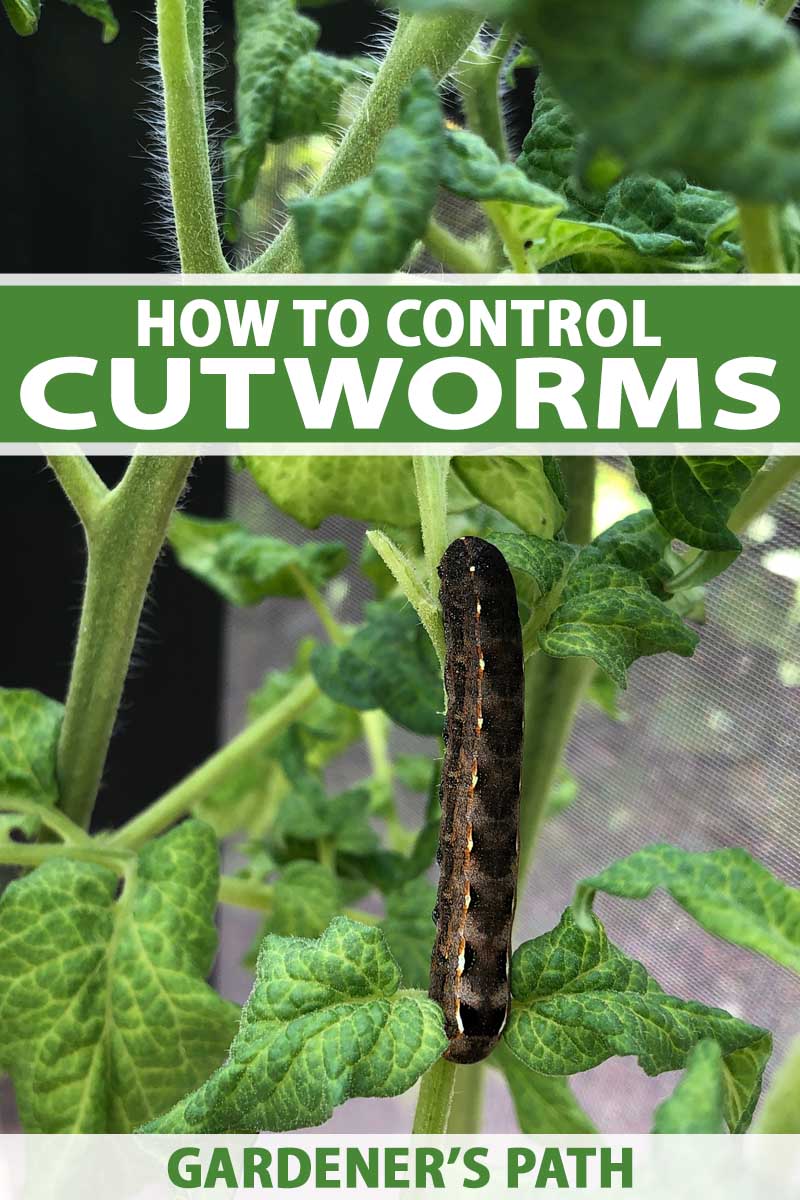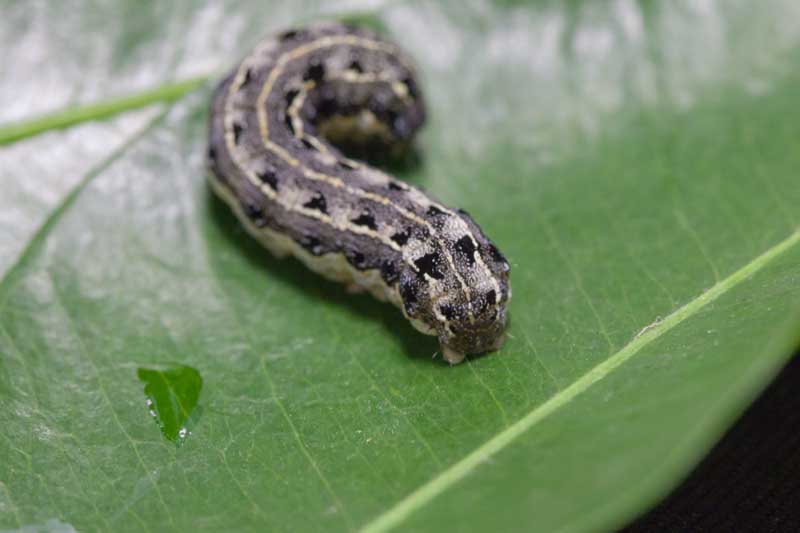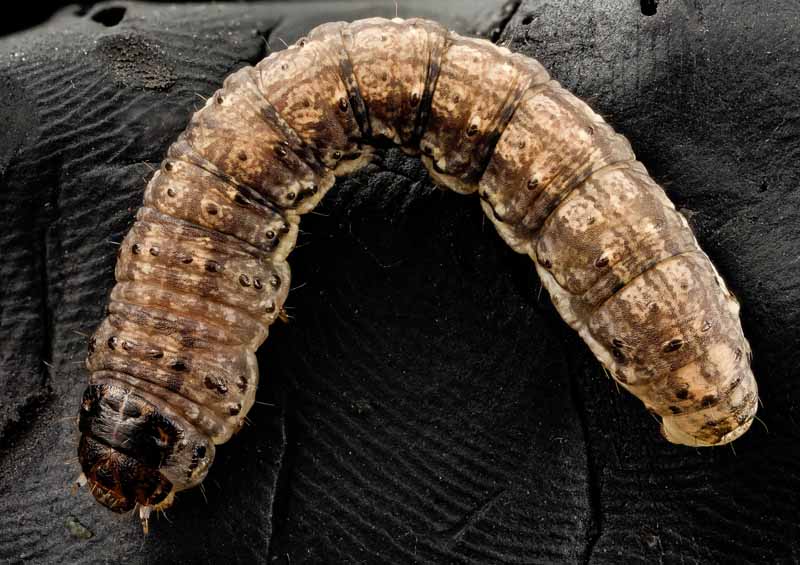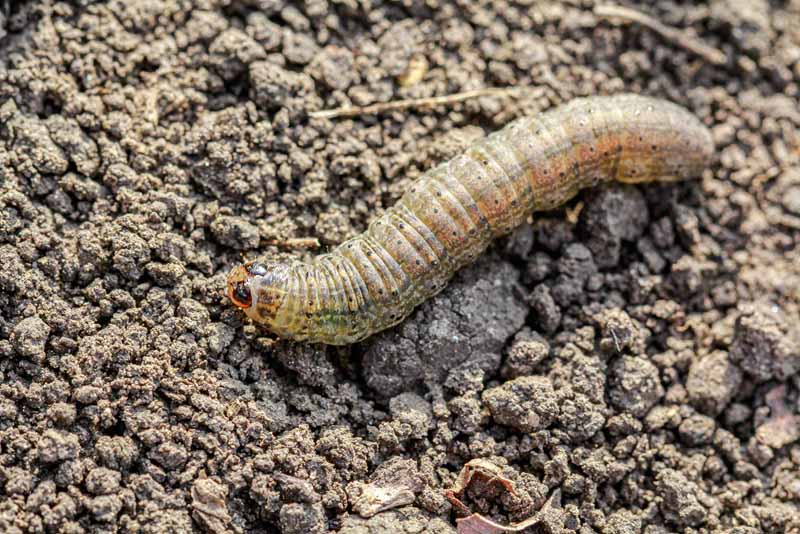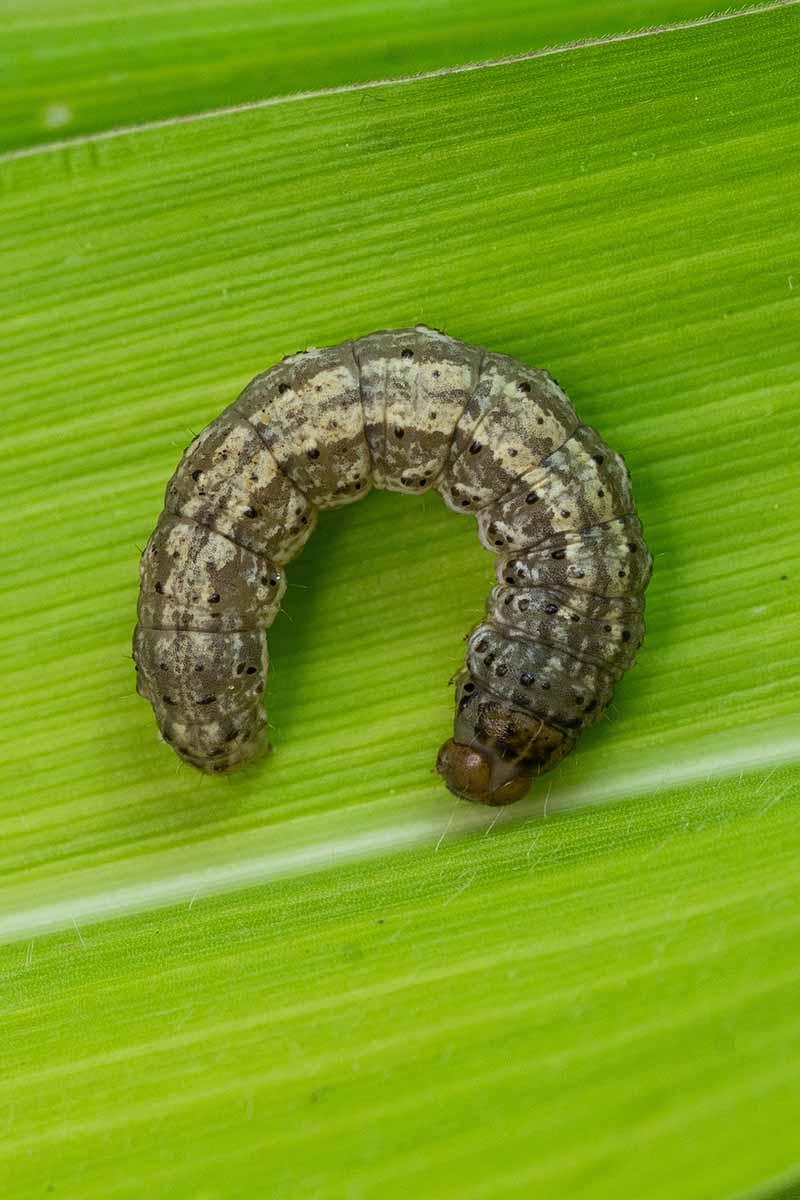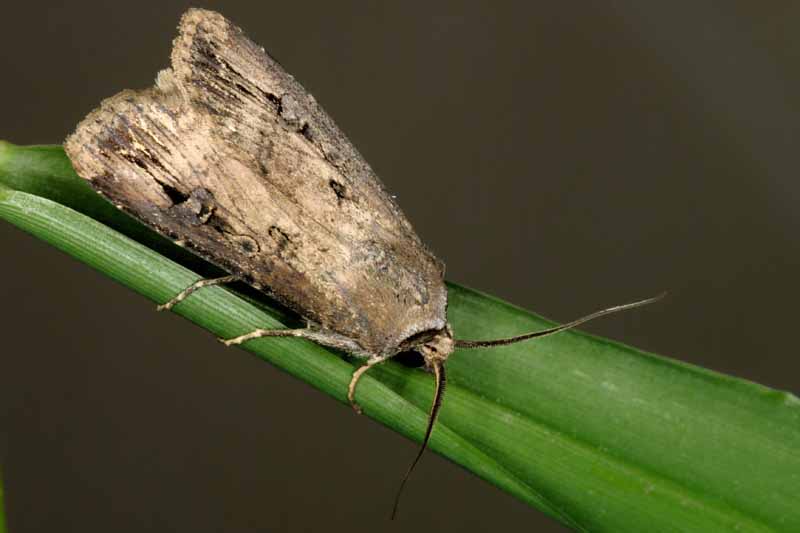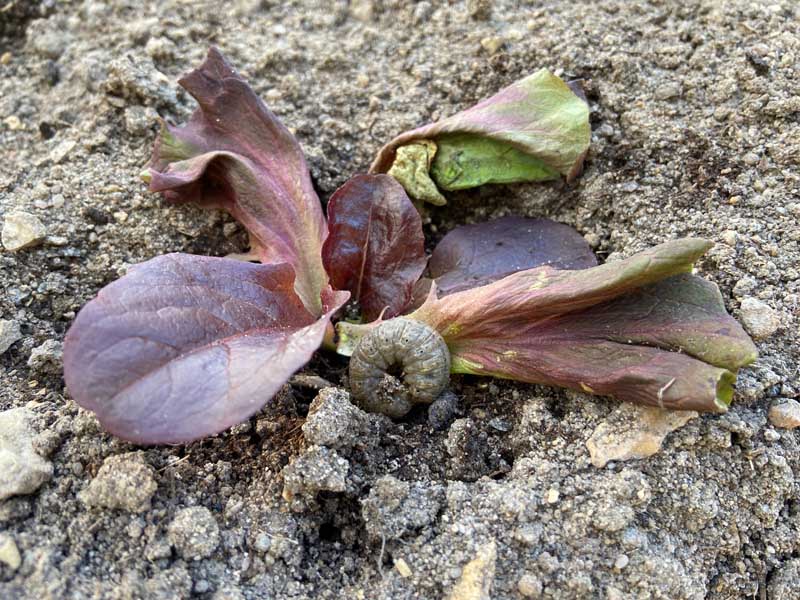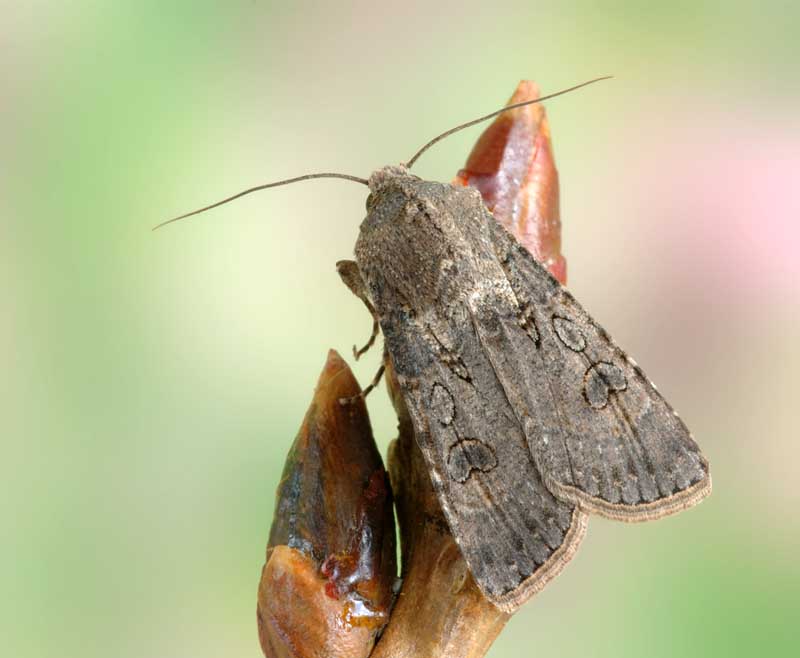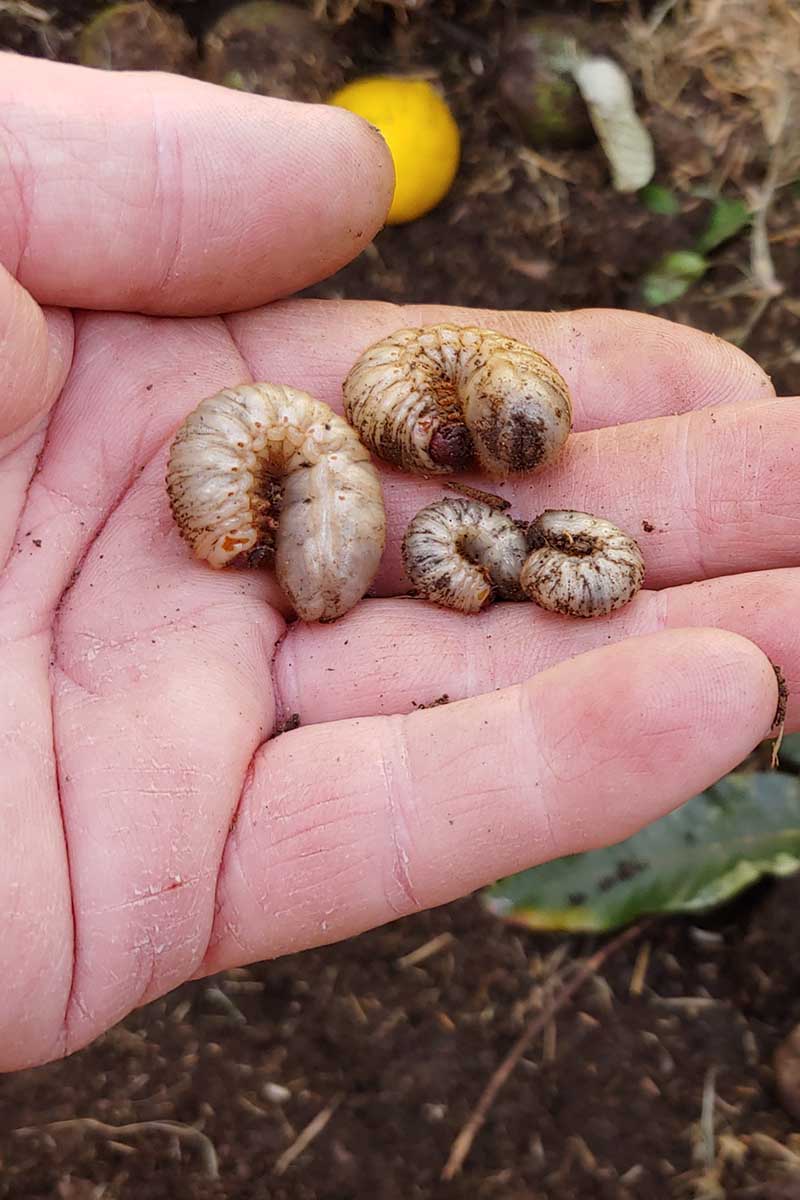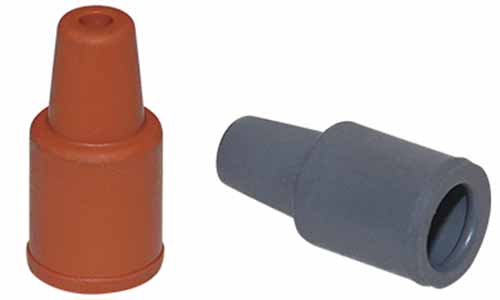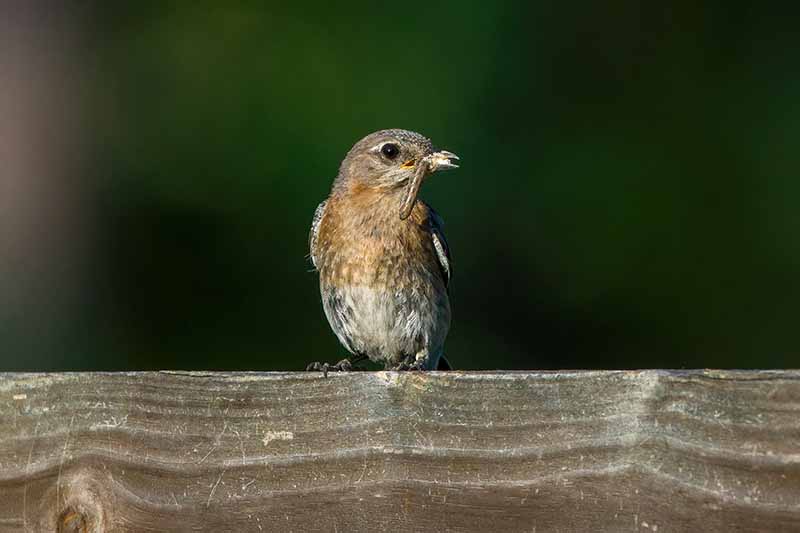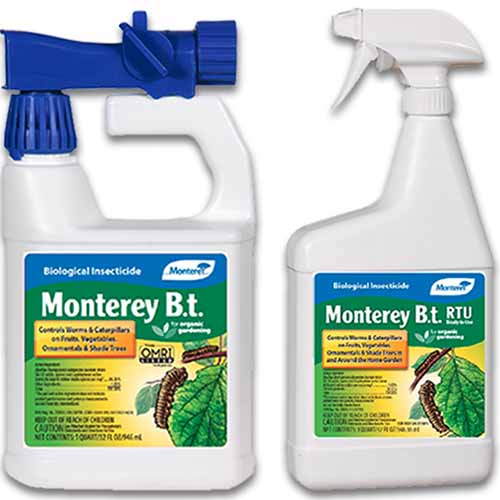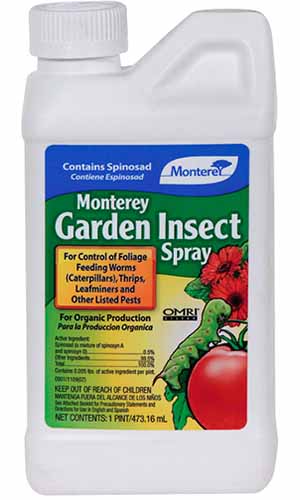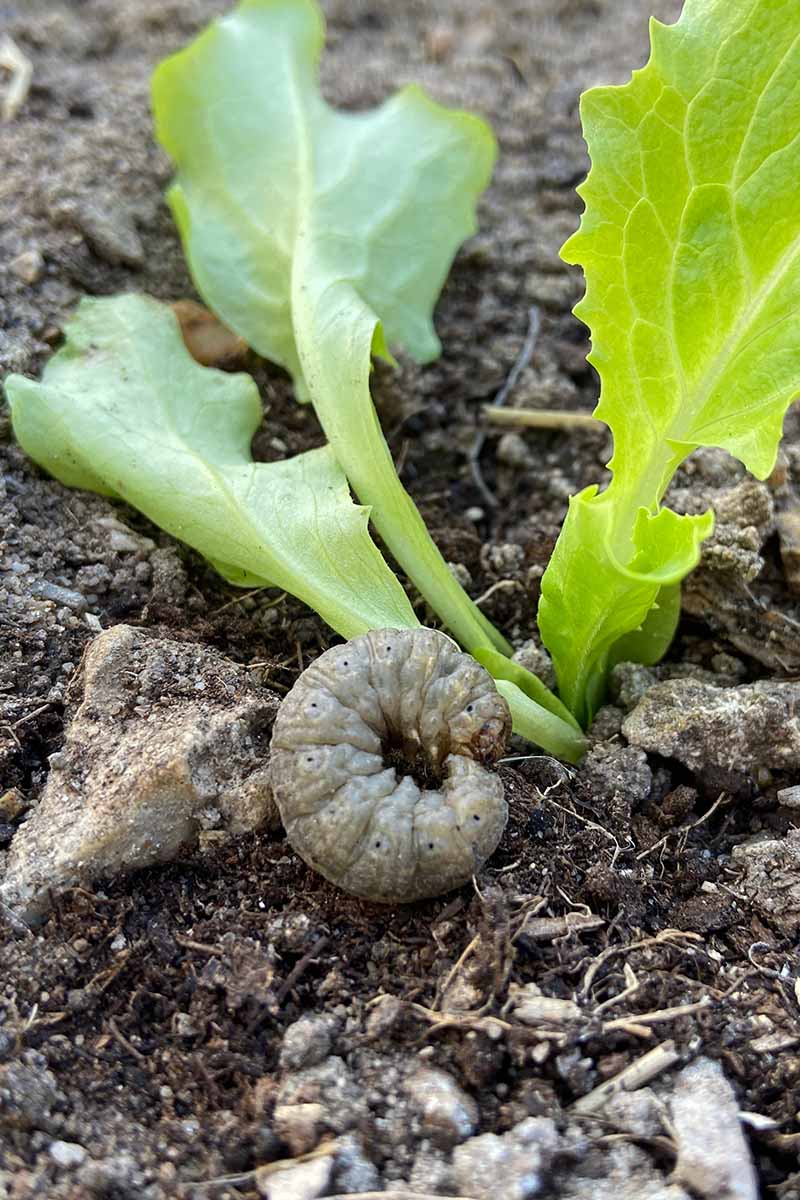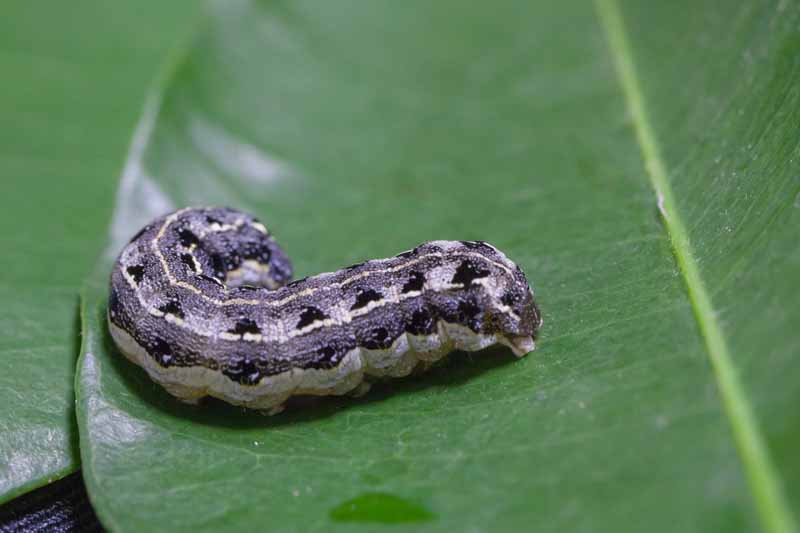Okay, that actually sounds kind of cute, but it’s a sign that you have cutworms, not an itty-bitty reaper in your garden. And it’s decidedly not adorable when your hopes for a bountiful harvest are dashed by this nefarious pest. We link to vendors to help you find relevant products. If you buy from one of our links, we may earn a commission. Here’s what you can expect: Start saving your used toilet paper rolls (we’ll explain later) – we’re going to war with cutworms!
What Are Cutworms?
The term “cutworm” refers to the larvae of moths in the Noctuidae family. The adult moths are known as miller, night-flying, or owlet moths and, not surprisingly given their common name, these are mostly active at night. By the way, this family is also the one where armyworms come from. Armyworms are an equally annoying grub-like pest that you might encounter, and they have a lot in common with cutworms. Cutworms got their name because they usually feed by chewing through the stems of young plants, cutting them down at the soil level. These pests exist on every continent on the planet except Antarctica. They even live in the Arctic! In other words, no garden is safe, unless perhaps you are gardening at the Davis Research Station. There are numerous varieties of cutworms that you can find in the US. The most common are the black (Agrotis ipsilon), bronzed (Nephelodes minians), dingy (Feltia jaculifera), glassy (Apamea devastator), granulate (Feltia subterranea), spotted (Xestia dolosa), army (Euxoa auxiliaris), winter (Noctua pronuba), red-backed (Euxoa ochrogaster), cutbacked (Agrotis gladiaria) and variegated (Peridroma saucia) cutworms. You might have just one type attacking your garden at a time, or you could have several at once. It doesn’t matter which one (or ones) you’re dealing with. They’re all treated the same, for the most part. The only thing that really varies is the timing of treatment. If your cutworms hatch in the spring, you can target your treatment for the springtime. But if they hatch year-round in your area, you’re going to have to take a broader approach. That said, you can find specific treatments aimed at some of the various species, but unless you are growing one main crop and are dealing with just one species, you don’t need to be that focused. The treatments in this guide will address all types of cutworms. Cutworms attack a massive range of plants, including grasses, herbs, fruits, vegetables, ornamentals, and weeds. Fruits like strawberries, grapes, melons, and tomatoes; veggies like corn, beans, squash, cole crops, and leafy greens; and annual flowers like violets, carnations, and primroses are all at particular risk. These pests do the most damage to young seedlings. Mature plants aren’t nearly as prone to damage.
Identification
Cutworms (which aren’t truly worms) look a lot like grubs or other varieties of caterpillars, and they are frequently mistaken for them. That’s because they can be spotted, striped, or solid, and range from dull to glossy. Their color can be cream, dark brown, or any hue in between. Obviously, coloring and pattern isn’t a good way to differentiate them from other worm-like pests. So how do you separate cutworms from other grub-like insects? Here’s what to look for: All of them are smooth, not hairy. Other caterpillars are often hairy, while cutworms can have very fine hairs, but they are only obvious if you use a magnifying glass to examine them. The majority of them tend to be most active in the evening or at night, while grubs and other caterpillars are active during the day. If you disturb or try to give cutworms a poke, they usually curl up into a ball. They also all have five or six pairs of true legs, and numerous additional false legs. Grubs, which are larvae of insects like flies and beetles, have one to three sets of legs. They can grow to nearly two inches long, but many are much smaller and stay around 1/8 inch long. I know this all sounds a bit vague, so here is what to watch for with some of the most common cutworm species. Black cutworms are one of the most common varieties in the eastern US. They are about two inches long, and dark gray with subtle stripes or spots. The adults have a two-inch wingspan and their forewings are dark brown, while the hindwings are light gray. They have small kidney-shaped markings on their wings. Army cutworms (not to be confused with armyworms) are common in the western half of the country. They grow up to two inches long, and are black or dark green, with orange and dark brown stripes and a white line down the tops of their bodies. The adults have a two-inch wingspan, and they are gray and brown. Their hindwings are lighter and the forewings have a dark brown pattern. Because they can vary in appearance so much, the easiest way to determine if you have cutworms in your garden is to keep an eye out for the worms and signs of their presence, like droppings and plants that have been cut off at the base. If you spot a worm, try poking it. Does it curl up into a c-shape? You’ve probably got yourself a cutworm there! While it’s pretty obvious if you see a young plant chewed through at the base that you have an infestation on your hands, these pests can do less distinct damage as well. For instance, cutworms can damage your lawn by clipping off the blades of grass. When you look at your lawn, you’ll notice dead patches. But it isn’t immediately obvious that the grass has been chewed through by a cutworm. Some cutworms can climb, which means they will scale plants to eat the leaves, stems, and fruits. Others, like the glassy cutworm, remain underground after hatching and they feed on plants’ roots. Black cutworms can tunnel beneath the soil. Tunneling types may stick their head out of the ground, clip off a blade of grass, and pull it down into their hole, so you won’t even see the cut down grass. Some species will tunnel into heads of lettuce. If you have a larger, more mature plant and it is cut down at the base, assume an herbivore like a deer or rabbit got to it instead, not cutworms.
Biology and Life Cycle
Let’s talk about the life cycle of cutworms. The adults lay eggs in masses, often on the underside of leaves, or sometimes on the upper side. They can also lay them in tucked-away areas like the underside of home siding, or under deck stairs. Still others lay on bare ground. Adults don’t damage plants, but they can fly long distances to lay their eggs. We’re talking over 60 miles in just a few days. Adults are brown, gray, tan, or yellow. Their hindwings are often lighter in color, but not always. Their wingspans can be as broad as two inches. A few days or weeks after laying eggs – depending on the temperature and the species – they will hatch and the larvae emerge. Depending on where they are laid and which species they are, the worms can look like an encroaching army, since they all emerge at once and start moving toward a food source as a group. It’s not unheard of for masses of them to assemble near the sheltered entryway of a home or outbuildings. This can be a pretty discomfiting sight. From there, they arrive at their food source and they start eating. This is the most damaging phase of their life cycle, and cutworms tend to damage young plants the most. Once a stem thickens or toughens up, the plant isn’t at risk. Most cutworm larvae stay in the same area after hatching, so where there is one… there are likely more! After a few months of feeding on your precious garden plants, the larvae pupate in the soil or under garden debris. They make a little chamber under the soil where they mature over a few days or weeks. The whole life cycle can take anywhere between 50 and 70 days. Some species have seasonal breeding patterns, while others breed continuously all year long, with up to half a dozen generations per year.
Organic Control Methods
Cutworms can cause devastating damage in the garden, but fortunately, they aren’t difficult to control. That’s especially true if you use a multi-pronged approach. Try combining a few cultural, physical, and biological control methods for the best chance at success.
Cultural
Keep your gardens clean to deny the worms a place to hide. That means removing weeds and any dead plant material. Try to keep a four-foot barrier of unplanted, clean earth between your lawn and your garden, since cutworms may hide out or feed on grass. The same goes for any nearby fields – maintain a bare strip of land between your garden and those as well. Tilling in the spring and fall, or any time your soil isn’t planted, exposes the larvae and pupae to predators. This won’t control for infestation entirely, but it serves as a useful element of an overall approach to keeping cutworms out of your garden. Don’t use mulch if you are struggling with an infestation. Dust mulch instead. While dust mulching isn’t the most effective method of mulching, it’s the best solution if you are struggling with a cutworm infestation, since organic mulch provides ideal hiding spots for the pests. If you’ve never tried dust mulching before, the process involves breaking up the top few inches of soil to create a textured layer.
Physical
Handpicking is effective, if time consuming. If you happen across a cutworm, grab it and drown it in soapy water or crush it. More likely, though, you’ll need to go hunting. The best way to do this is to visit the garden where you know they’ve been previously. Do this in the evening with a flashlight. Snatch as many as you can find, and destroy them. At the same time, you can also try digging down a few inches into the soil, or use a soap flush near the plants they are feeding on to expose them. To do a soap flush, mix one tablespoon of lemon dish soap with one gallon of water, and pour it all around your garden. The pests will emerge and you can grab them. Collars are extremely effective if you use them right. Collars simply prevent the cutworms from reaching plant stems. You can make them out of tinfoil, cardboard, plastic, or anything else that provides a protective barrier. I have a friend who made some wood collars that he can reuse each year. In order to be effective, you need to sink the collar a few inches deep into the soil, and it needs to extend several inches above the soil line all the way around the stem. The simplest method is to use a cardboard toilet paper roll. Cut it lengthwise on one side, dig a little ditch around your plant, open the toilet paper roll, and put it around the seedling’s stem with one end resting in the ditch you made. Close the roll and firm up the soil around it. By the time the roll deteriorates in the garden, your plant should have grown enough to no longer be at risk. If you use something that won’t decompose, be sure to remove it before the plant gets too large and it’s stuck in place. Obviously, this won’t work for your lawn. It’s only a good option if you have a handful of individual seedlings to protect. Instead, plant trap crops like sunflowers or cabbage on the perimeter of the garden. If you use this technique, you must go out in the evening to handpick and destroy the pests that are drawn to them. Since you are giving them an abundant source of food, this can help to increase their numbers. Adults are attracted to crops like mustard, lamb’s-quarter, and quack grass. Plant these away from your garden and hang traps. Finally, you can try sprinkling diatomaceous earth (DE) around your plants. You can purchase sticky pheromone traps targeted at various types of cutworms. For instance, Arbico Organics carries Scentry Lures aimed at catching Western bean cutworms (Loxagrotis albicosta) in packs of five and 10. Scentry Lures Speaking of traps, you can make a DIY trap by sinking a shallow dish (or dishes) into the ground and filling it with cornmeal. The worms like to eat cornmeal, but they can’t digest it. They’ll eat it and die. You can also sprinkle cornmeal around your plants, but it tends to degrade quickly and sink into the soil, and doesn’t work as long as it would if you placed it in saucers. DE cuts the bodies of soft-bodied insects, dehydrating and killing them over time. But I’ll tell you from experience, I have surrounded my plants with DE many, many times and the cutworms still got them. It does seem to discourage them, however, because it’s an irritant. If you’re going to use DE, I recommend using it in combination with a few of the other techniques described here.
Biological
Braconid and trichogramma wasps and tachinid flies all attack cutworms. Buy or encourage them to hang out in your garden. You can also use beneficial nematodes to help keep populations under control. Parasitic nematodes (Steinernema carpocapsae) should be applied in the morning or evening to be most effective. Learn more about how to use beneficial nematodes in our guide. There are many predators that love nothing more than biting into a big, fat, juicy worm. Birds, rodents like voles and rats, spiders, lizards, and soldier beetles are all your allies in this battle, so do what you can to encourage them to visit your garden. Birds and bats will also eat the adults. If you’ve been mulling over whether you should install a bat box, now is the time to put one up.
Chemical Pesticides
This is one pest where there are so many other effective options that you should really consider whether you need to turn to chemical pesticides. I recommend leaving these as an absolute last resort. Milky spore (Bacillus popilliae) takes some time to work, but if you apply it following the manufacturer’s directions, it can help to stop an active infestation and prevent future infestations as well. Milky Spore Grub Control Mix Bacillus thuringiensis is another helpful species of bacteria. Both the kurstaki (Btk) and aizawai (Bta) subspecies work well, so long as you use them when the larvae are young. Once they grow older, these products aren’t as effective. The nice thing about these products is that they don’t harm beneficial insects like honey bees or ladybugs. Monterey Bt Spray If you want to purchase some to add to your arsenal in the battle against cutworms, Arbico Organics has 32-ounce ready-to-use spray or hose-end bottles of the kurstaki subspecies.
Organic Pesticides
Spinosad is an all-purpose natural insecticide that works on cutworms, as well as a range of other pests, but it won’t harm most beneficial insects. Monterey makes a product called Garden Insect Spray that contains spinosad. Grab some at Arbico Organics in pint, quart, or gallon-size containers. Mix it with water and apply in the evening. Monterey Garden Insect Spray Products containing pyrethrins can be effective, but you need to apply them when the larvae are young for it to work. These products are naturally derived from chrysanthemum flowers. Monterey Take Down Garden Spray Monterey Take Down Garden Spray with pyrethrin comes in pint-size concentrate and 32-ounce ready-to-use containers. Pick some up at Arbico Organics. Chemical pesticides tend to have unintended negative consequences for the environment, such as killing off beneficial insect populations. Frequent use may also cause insects to develop an immunity over multiple generations, rendering the chemicals less effective in cases when we truly need them. That being said, sometimes desperate times call for desperate measures. If none of the options described above are working, you have a few options. Products containing permethrin, a synthetic pyrethroid, are best used on grasses and brassicas. Carabyl, which is often sold under the name Sevin, can be used on vegetables. You can find baits or sprays that use carbaryl. Carabyl is a carcinogen; don’t eat anything sprayed with this chemical until at least two weeks have passed since spraying. Apply it in the afternoon, following the instructions provided by the manufacturer. Finally, cyfluthrin is another chemical pesticide that may also be used. You can buy an all-purpose liquid insect killer containing this product, which you can apply to lawns and plants that you don’t intend to eat. Apply it in the evening, when the wind isn’t blowing and when there isn’t any rain in the forecast overnight. Some pests start out nibbling on leaves or sucking sap out of plants, and you at least have a chance to rid your garden of them before your plant is done for. But with cutworms, sometimes you don’t even know you have a problem until your seedling is lying dead on the ground. Now, you’re equipped to deal with the problem if they pop up. Act quickly to avoid losing your entire garden to these little jerks. Then, tell us which method you found most effective – or if there are any great treatments we missed! If you’re dealing with other pests in your garden, take a look at these guides next:
How to Detect and Control Spider Mite InfestationsHow to Identify and Control MealybugsHow to Identify and Control Currant Fruit Flies
